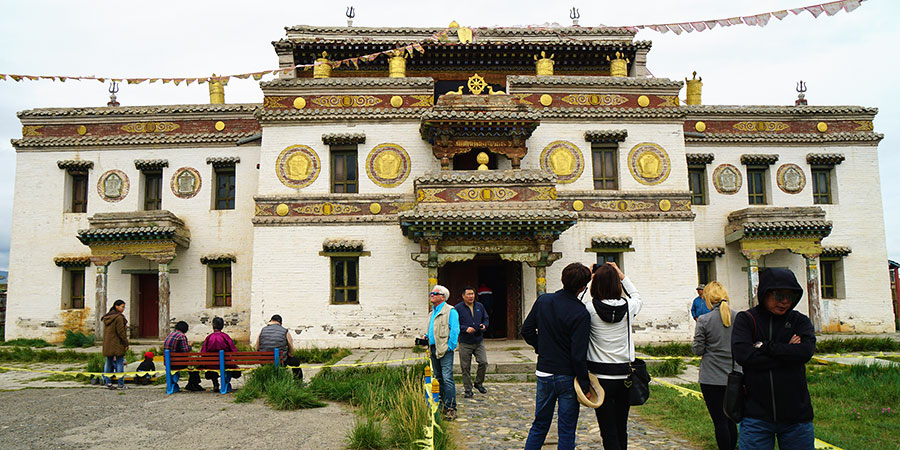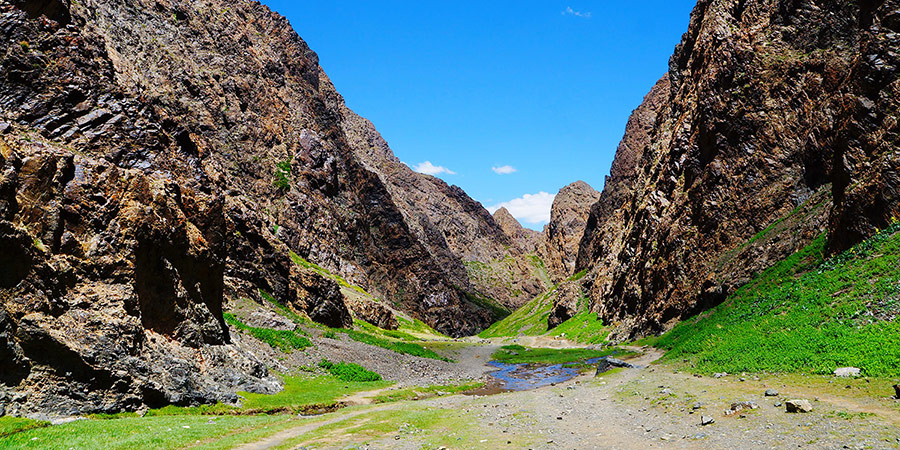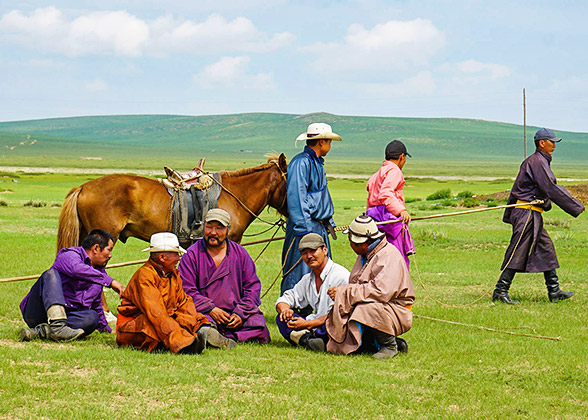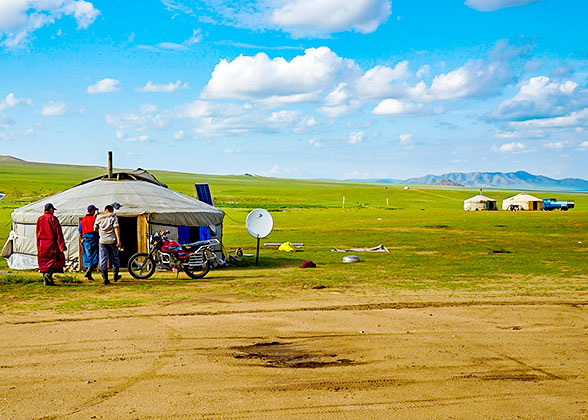Day 1: Arrival in Ulaanbaatar, Airport or Railway Station Pick-up
Today, you will be welcomed by our guide and the driver at the airport or the train station in Ulaanbaatar to start your Mongolia adventure! Then, we will escort you to the selected hotel. The rest of the day, you are free to do whatever you like, such as walking around to familiarize yourself with the country or resting in your hotel room to replenish energy from the long journey.  Free Time Suggestion: You can walk to Sukhbaatar Square at the very center of the city, where Mongolia’s important buildings stand, such as the National Palace, the seat of the Mongolian president, government, and parliament. At its doorway, a majestic bronze statue of Genghis Khan is set to commemorate his great triumph. In Mongolian, “Genghis” carries multiple interpretations. Some suggest it is associated with strength and power, while others believe it means “divinely ordained”, and Genghis Khan is the ruler that god sent to Mongolia. There is also an interesting folklore saying that a bird perched outside Temüjin’s (original name of Genghis Khan) tent before his coronation, chirping “Genghis, Genghis…,” which was thought to be a sign of God’s approval, so he was honored “Genghis Khan.”  Insider Tips 1. The traffic in Ulaanbaatar is very congested, with fewer streets but more vehicles. Please pay more attention to safety when taking a walk on your own. 2. In winter (November-February), Ulaanbaatar has serious air pollution problems, and you are advised to bring masks when visiting at that time. Accommodation: Grand Hill Hotel Ulaanbaatar (4 stars) or similar
|
Day 2: Ulaanbaatar - Hustai National Park
When talking about Mongolia, most people always think about horses and grassland. Today, our guide will escort you to Hustai National Park, home to the world’s only living pure wild horses, Przewalski's horses, which have bigger heads, shorter hair, and lower bodies than domestic horses. Get your binoculars ready, since you can only spot these precious animals from 200 meters (656 feet). In addition, the park provides shelter to hundreds of other animals, such as roe deer, Mongolian gazelles, and corsac foxes. We specially arrange a one-hour horse ride for you to explore the natural paradise, during which you can view various queer rock formations and encounter wild horses if lucky. Tonight, stay in a ger, the traditional dwelling of local herdsmen, to experience the nomadic life.
Meals: Breakfast, Lunch, Dinner
Accommodation: Hustai Ger Camp or similar
|
Day 3: Hustai National Park - Karakorum (Kharkhorin)
Today, we will move on to Karakorum, the capital and base camp of Genghis Khan and the “political center of the world” back in the early to mid-13th century. Regretfully, it was destroyed by the continuous wars in the 14th century, leaving only some debris of walls, palaces, markets, etc. Since the late 16th century, the region has turned into Mongolia’s center of Lamaism, thanks to the construction of Erdene Zuu Monastery, the first and biggest Lama monastery in the country. The monastery we will see today was rebuilt partially with stones from Karakorum ruins, in a combined style of Mongolian, Tibetan, and traditional Chinese. In 2004, the Karakorum and Erdene Zuu Monastery were included in the UNESCO World Cultural Heritage list as part of the Orkhon Valley Cultural Landscape.  Why Ger Camp but Not a Hotel? Gers are the only choices to stay overnight when traveling in the countryside before returning to Ulaanbaatar. They are something like a moving hotel, equipped with shared bathrooms in separate blocks. Generally, most gers are close to the sights, which will leave you more time to admire the stunning sceneries. Moreover, staying in a ger is one of the best ways to experience Mongolian tradition and culture. Meals: Breakfast, Lunch, Dinner Accommodation: Urgoo Tourist Camp or similar
|
Day 4: Karakorum - Tsenkher
After breakfast, set out to enjoy Mongolia’s most famous Tsenkher Hot Spring. Heated by the ancient volcanoes, the hot water gushes from the ground at a temperature of 85.5 ° C (185.9 ° F). It is said that the water contains minerals including hydrogen sulfide, sodium carbonate, bicarbonate, sulfate, and fluorite and is good for joint diseases and nervous system diseases. Dip in an outdoor spring pool under the blue sky while appreciating the vast grassland, breathing fresh air mixed with the fragrance of grass, and hearing yaks mooing. Please remember to remove your silver ornaments, or they may react with the chemicals in the water. Later, the guide will accompany you to knock on the door of a yak breeder and step in to pay a visit.
Meals: Breakfast, Lunch, Dinner
Accommodation: Duut Resort or similar
|
Day 5: Tsenkher - Tuvkhun Monastery
We will spend the whole day visiting Tuvkhun Monastery, one of the oldest Buddhist monasteries in the country. It stands on a mountain peak, which is considered to be an auspicious location. Upon arrival at the foot of the rocky hill by car, we need to get off and approach the monastery by horse or foot. The whole monastery consists of 14 small temples with red walls, green roofs, delicate carvings, and vivid sculptures. Also, a whole view of the grassland underfoot can be gained here.  Where to Find a Toilet During the Long Transfers There is a saying spreading on the steppes: Wherever there are people, there must be toilets; wherever there are no people, toilets are everywhere. The vast steppes are sparsely populated, and it is impossible to build public toilets with good conditions like those in big cities. Once there is one, it must be very simple, say, surrounded by a few wooden boards on three sides without a roof or door. Of course, it is also relatively safe because there is no one around. Our tour guide and driver are familiar with all the places along the way and will stop at the proper place for you to take a long breath, stretch your body, and answer nature's calls. We believe such an experience is an indispensable part of the adventure. Meals: Breakfast, Lunch, Dinner Accommodation: Tuvkhun Ger Camp or similar
|
Day 6: Tuvkhun Monastery - Ongi Monastery
This morning, we will head toward our next destination by car - Ongi Monastery. It used to be a grand architectural complex along the Ongi River, mainly made up of the Barlim Monastery and the Khutagt Monastery. As time passes by, nowadays we can only tell its past prosperity from the vast ruins. These ruins, along with fresh trees, make up the wonderful landscape of the riverside. After that, the guide will escort you to hike a Gobi mountain, which will last for about an hour or so.
Meals: Breakfast, Lunch, Dinner
Accommodation: Ongiin Nuuts Ger Camp or similar
|
Day 7: Ongi Monastery - Flaming Cliffs (Bayanzag)
The only stop of today’s escorted tour will be Flaming Cliffs, famous for the first discovery of dinosaur eggs. It gets the name because the surrounding crimson rocks flicker like a fire under sunshine. The views are especially magnificent at sunset, when the cliffs are dyed orange or bright red.  Who Found the Dinosaurs' Egg Fossil? Roy Chapman Andrews, an American explorer and paleontologist, used to be the director of the American Museum of Natural History, famous for his scientific exploration in China, Mongolia and other places at the beginning of the 20th century, from which he and his team had many important discoveries, including the discovery of dinosaur egg fossils for the first time. During four expeditions in the Gobi from 1922 to 1925, he found precious dinosaur bones and a nest of dinosaur eggs, which made great contributions to the study of dinosaurs. Try your luck here, and maybe you can get something special. Meals: Breakfast, Lunch, Dinner Accommodation: Mongol Gobi Ger Camp or similar
|
Day 8: Bayanzag - Khongor Sand Dunes
Have a big breakfast today. Afterward, our private guide and the driver will escort you to the largest and most typical sand dunes in Mongolia: Khongor Sand Dunes, which extend as long as 180 kilometers (110 miles) with a general width of 3-5 kilometers (2-3 miles). Due to the continuous wind blowing, most dunes reach a height of 100-300 meters (330-980 feet). The locals also call the sand dunes “Singing Sand” because it produces sound when the wind blows.
Meals: Breakfast, Lunch, Dinner
Accommodation: Gobi Discovery Ger Camp or similar
|
Day 9: Khongor Sand Dunes - Eagle Valley (Yol Am)
After breakfast, move on to Eagle Valley. It is an incredible valley covered with ice even in summer. The guide will accompany you to hike into the ice field to enjoy the amazing landscape while breathing the fresh air. En route, we will probably encounter animals like voles, rabbits, camels, and lambs, as well as eagles in the sky. Meals: Breakfast, Lunch, Dinner Accommodation: Juulchin Khan Bogd Ger Camp or similar
|
Day 10: Eagle Valley - Tsagaan Suvarga
Today, we will explore the peculiar Tsagaan Suvarga. Ochre or pink cliffs here have been elaborately carved into different shapes by the wind over the years. Viewed from specific angles, it resembles a complex of white stupas, hence also known as the “White Buddha Pagoda” in Mongolia. As the sun sets, the brilliant colors on the cliffs gradually fade, and then the earth presents a hazy, light pink color. You can climb up the rocks to observe the color changes. Do not forget to take photos while appreciating these “works of nature”, most of which are limestone formations.
Meals: Breakfast, Lunch, Dinner
Accommodation: Gobi Suvagra Ger Camp or similar
|
Day 11: Tsagaan Suvarga - Baga Gazriin Chuluu
Baga Gazriin Chuluu also features huge rock formations in the Gobi Desert, with high mountains above 1,700 meters (5,577 feet). The locals hang scriptures on its top, praying for the blessings of gods and Buddha to ensure the safety of people, livestock, and good weather. Its endless granite landscape gives the impression of being in another world. The most unforgettable sights are the Usan Bolortiin Agui cave and the hidden springs beneath the rocks. Although it is not drinkable, you will feel cool at a glance in the hot summer. Besides, you will also have chances to encounter various kinds of wild creatures. The guide will also escort you to trace the ruins of a 17th-century temple. Meals: Breakfast, Lunch, Dinner Accommodation: Baga Gazriin Chuluu Ger Camp or similar
|
Day 12: Baga Gazriin Chuluu - Ulaanbaatar
There are no sightseeing stops today. After breakfast, our driver will safely send you back to the hotel in Ulaanbaatar. The total traveling distance reaches about 250 kilometers (155 miles). But you will not feel bored at all because the scenery outside the window is quite picturesque, and you can ask the driver to make stops anytime to take great photos. After check-in upon arrival, enjoy some free time for a hot shower to revive yourself.
★ Feel the Charm of Mongolian Folk Music and Dance ShowTonight, we will specially arrange a Mongolian dance and music dinner show for you to round off the holiday. The morin khuur, a unique musical instrument of the Mongols, is performed by people wearing traditional costumes. Mongolian herdsmen have a special affection for the Morin khuur, and the sound is really pleasant. Some people praise that the melody of a Morin khuur is far more vivid than the colors of the painter and the language of the poet to describe the magnificence of the steppes. When the joyful music is played, combined with the grandeur of Mongolian dance, it may help you recall the happy moments of your journey. Hope you enjoy this arrangement.
Meals: Breakfast, Lunch, Dinner
Accommodation: Grand Hill Hotel Ulaanbaatar (4 stars) or similar
|
Day 13: Ulaanbaatar Airport See-off
This private Mongolia adventure will come to an end here. At the agreed time, our driver will send you to Chinggis Khaan International Airport and see you off. Hope these wonderful days will linger in your mind!  Suggested Visiting Time: May - October The weather is sunny and mild most of the time from May to October in Mongolia, and the annual Naadam Festival will be held from July 11-13, during which you can experience the authentic nomadic culture through watching the exhilarating archery, wrestling, and horse racing. Winter (November-January) is quite chilly when the grasslands are covered with snow and the rivers are frozen. However, if you happen to visit here during this period, you will have a chance to celebrate the Mongolian Lunar New Year, Tsagaan Sar, to admire Mongolian traditional attires, and drink their homemade kumiss (fermented mare milk). The date is different every year according to the lunar calendar, generally from January to March. If you are interested in Naadam Festival or Mongolian Lunar New Year, just contact us, and we will tailor the itinerary for you! Meal: Breakfast
|







